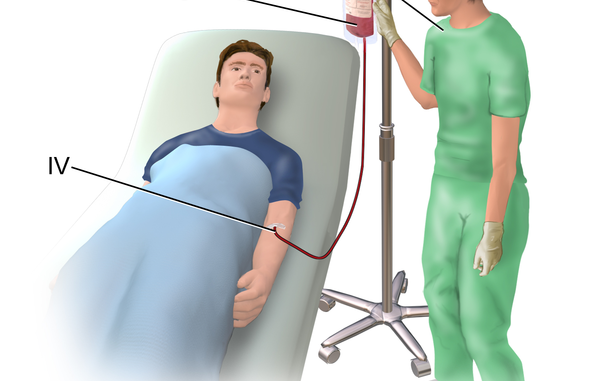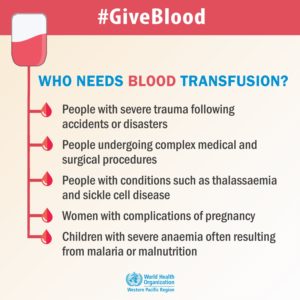
Table of Contents
What is Blood Transfusion?
- Blood transfusion is the process of transferring blood (intravenously) into a person’s circulation.
- Blood transfusion is a reasonably simple medical procedure which involves the transfer of blood or blood components into a person’s body through an Intravenous line (IV)
- It is a technique for replenishing your body’s blood after an illness or injury.
- A patient receives entire blood or one of its components during a transfusion via an IV, a little needle is used to introduce this tiny tube into a vein.
- Blood transfusions are frequently performed as a life-saving measure to replenish blood cells or blood products lost through trauma, injury, or significant bleeding during surgery, as well as to boost anemic patients’ blood counts.
Components of Blood
Blood has multiple components. They are:
- Red cells: It carries oxygen and help remove waste products
- White cells: It helps the body to fight infections
- Plasma: It is the liquid part of our blood
- Platelets: It helps the blood to clot properly
Types of Blood Transfusion
The American Red Cross lists the following four common types of blood transfusion:
- Red blood cell transfusions: If a person has lost blood, or has anemia (such as iron deficiency anemia), or has a blood condition, they may need a red blood cell transfusion.
- Platelet transfusions: Patients who have reduced platelet counts due to chemotherapy or a platelet disease may benefit from platelet transfusions.
- Plasma transfusions: Plasma includes proteins that are crucial to good health. If a person has had serious burns, infections, or liver failure, they can need a plasma transfusion.
- Whole blood transfusion: If a patient needs red blood cells, white blood cells, and platelets and has suffered a significant traumatic hemorrhage, a whole blood transfusion may be given.
Conditions When Blood Transfusion Is Done
- A severe injury with significant blood loss
- Surgery that resulted in significant blood loss
- Blood loss following delivery
- A liver issue that prevents your body from producing specific blood components
- A bleeding condition, like hemophilia
- A condition that results in decreased or poor-quality RBCs (anemia)
- Kidney failure that affects the ability to produce blood cells.
- Treatment for cancer that reduces your body’s capacity to produce blood cells
Benefits/Advantages
- Blood is an essential component of life. You may be at danger of dying if you don’t have enough blood or one of the components of blood.
- The heart and brain receive oxygen from the body’s red blood cells. For life to continue, there must be enough oxygen in the body.
- Platelets aid in the prevention or control of bleeding caused by a low platelet count.
- Additionally, plasma and cryoprecipitate aid in reducing or stopping bleeding.
- A blood transfusion can prevent life-threatening complications from extreme blood loss and preserve a patient’s life.
- Significant bleeding can result in dangerously low hemoglobin levels and harm to internal organs from a lack of oxygen.
- If bleeding persists, the body’s plasma and platelet production will also decline. If this happens, bleeding will not cease and blood cannot clot.
Time to Recover
- After transfusion, a medical professional may advise resting for 24 to 48 hours.
- It’s crucial to call the healthcare professional and set up a follow-up appointment as well.
Risks During Blood Transfusion
- Transfusions of blood are a common and extremely safe procedure.
- Before being utilized, all donated blood is examined to rule out the presence of dangerous illnesses like HIV or hepatitis.
- Complications include an allergic reaction to the donor blood as a very minor possibility and an issue with immune system (the body’s fight against disease and infection), heart, or lungs
- Unless it is impossible, such as if you require an emergency transfusion, the risks will be discussed with you prior to receiving the transfusion.
Seeking Medical Help after Blood Transfusion
Some adverse reactions can be seen immediately a day after the blood transfusion or after several months of transfusion. We must consult a health care provider, if the following symptoms are seen. The reactions that require immediate medical attention are:
- Bleeding, pain or new bruising at the IV site
- Cold and clammy skin, fever or chills
- Dark or reddish urine
- Rapid heartbeat, chest pain, trouble breathing or wheezing
- Headache, dizziness, nausea or vomiting
- Rash, hives or itching
- Severe back pain
Blood Transfusion Safety
In order to ensure safety, certain precautions and rules must be followed such as:
- Before giving blood for transfusion, the donor must fill out a questionnaire revealing any past histories of infectious diseases and other health conditions.
- The hemoglobin level of the donor is measured. After it has been drawn, the blood is tested and checked for potential infectious diseases including HIV and hepatitis.
- To ensure compatibility, the blood from the donor is cross-matched with a sample from the patient. The antigen profile of a person’s red blood cells determines blood group. Each person has an ABO blood type, which can be blood group A, B, AB, or O. This indicates that their red blood cells may express antigen A, antigen B, both antigens, or neither antigen. Additionally, each person has either a positive or negative Rh antigen test result. These antigens collectively can result in eight different blood types.
- Only patients who truly stand to gain from the surgery are taken into consideration for transfusion. To assess the amounts of the different blood components, such as red blood cells, white blood cells, and platelets, a complete blood count is done. Testing for coagulation (clotting) is also done.
- Through tubing attached to a needle or catheter supplying the vein, the blood is transfused. The needs of each patient determine how much blood is transfused.
- Vital indicators like temperature, heart rate, and blood pressure are closely watched during transfusion.
- A sudden fever in some people is possible during or within 24 hours of the transfusion; this condition can be treated with acetaminophen or paracetamol. The white blood cells in donated blood can cause reactions like this fever.
Blood Borne Infection
- Blood-borne illnesses are spread through direct blood contact from one person to another via wounded skin or a mucous membrane.
- The viruses hepatitis B, hepatitis C, and the Human Immunodeficiency Virus (HIV) are examples of blood borne infections (BBIs).
References and For More Information
https://my.clevelandclinic.org/health/treatments/14755-blood-transfusion
https://www.saintlukeskc.org/health-library/when-you-need-blood-transfusion-adult
https://www.lhsc.on.ca/perioperative-patient-blood-management-program/benefits-risks-of-blood-transfusion#:~:text=What%20are%20the%20benefits%20of,to%20a%20lack%20of%20oxygen
https://www.urmc.rochester.edu/encyclopedia/content.aspx?contenttypeid=135&contentid=315
https://www.redcrossblood.org/donate-blood/blood-donation-process/what-happens-to-donated-blood/blood-transfusions/reasons-transfusions.html
https://www.webmd.com/a-to-z-guides/blood-transfusion-what-to-know
https://www.nhs.uk/conditions/blood-transfusion/#:~:text=For%20example%2C%20you%20may%20need,chemotherapy%20or%20stem%20cell%20transplants
https://www.medicalnewstoday.com/articles/327513#risks-and-complications
https://www.who.int/health-topics/blood-transfusion-safety#tab=tab_1
https://www.ncbi.nlm.nih.gov/books/NBK539826/
